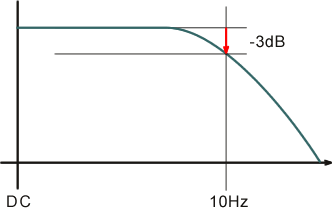

Both torque and rotation are outputted after passing through the first low-pass filter of 10 Hz cutoff frequency (refer to the following figure). The gain is -3 dB (1/√2) for 10 Hz, and the gain 1 (through) is for 2 to 3 Hz or less. Please note that the TS-410 is not suitable for the measurement of torque fluctuation and its timing (phase) monitoring.

The followings are the explanation of the concept of above.
When the voltage output fluctuation is around 3 Hz or less, the gain 1 (through) is outputted as it is and from then the gain is outputted while decreasing little by little.

When the signal is 10 Hz or more, the voltage is smoothed by the low-pass filter of 10 Hz to output.

When the signal is fluctuated in a ramp state, the voltage is followed up with a little delay depending on the increasing curve of the ramp increasing.

When the signal is fluctuated in a step state, it takes time equivalent to T constant time to reach 63 % of the step destination.

Caution:
Constant time T and low-pass filter cut-off frequency f are in the following relation.

Therefore, when the frequency is 10 Hz, T is around 16 ms.
The TS-3600 has the response of time constant display, but it cannot compare the response of TS-410/200 with that of TS-3600 because electrical processing is different. Please regard above calculated value only as a rough guide.
Revised:2008/09/30